Summary
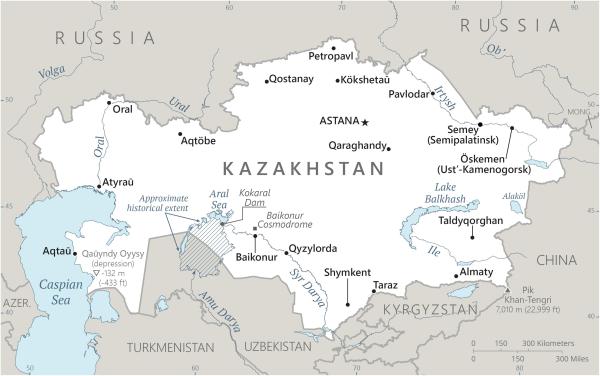
Map of Kazakhstan
Kazakhstan is a presidential republic in Central Asia that has a repressive centralized government. The country is bordered by Russia to the north, by Turkmenistan, Uzbekistan and Kyrgyzstan to the south, and by China to the east. Since its independence in 1991, Kazakhstan has not had democratic governance. Freedom House has categorized it as Not Free since 1994.
From the mid-18th century, most of present-day Kazakhstan was part of the Russian Empire. After the Russian Revolution in 1917, Kazakh leaders formed an autonomous republic, but the Bolshevik Red Army retook control in 1920 and the territory was incorporated into the Russian Soviet Federated Socialist Republic (RSFSR). In the framework of the Union of Soviet Socialist Republics (USSR), Kazakhstan was made an autonomous republic and then, in 1936, it was elevated to one of eleven union republics in 1936. (Later, there were a total of 15 union republics with Soviet occupation and incorporation of the Baltic countries and Moldova.)
As the USSR collapsed, Kazakhstan declared independence in December 1991. From then to March 2019, Kazakhstan had a single leader, Nursultan Nazarbayev, the former Soviet republic’s Communist Party First Secretary. As president, he replaced communist dictatorship with autocracy, having full control over the state and security services. Opposition parties, media, trade unions and civic organizations are repressed or under government control. In 2019, Nazarbayev stepped down as president, replaced by chairman of the Senate Qasym-Jomart Toqaev. His initial promises of reforms proved empty. In January 2022, he violently suppressed protests over price increases, assisted by Russian armed forces.
Since its independence in 1991, Kazakhstan has not had democratic governance. Freedom House has categorized it as Not Free since 1994.
Kazakhstan is the world's ninth-largest country in area (2.7 million square kilometers) and it has the world’s second longest land border (4,750 miles), that with Russia. Kazakhstan is one of the least densely populated countries with just 19.8 million people. Russian migration made ethnic Kazakhs a minority in their own country, but many Russians returned to Russia after the Soviet collapse. Today, the population is 70 percent Kazakh. According to the International Monetary Fund, Kazakhstan’s 2024 nominal Gross Domestic Product (GDP) is projected to be $297 billion (48th in the world). GDP per capita is projected to be $14,779 per year (68th in the world). The 2023 Transparency International report ranks Kazakhstan 98th out of 180 countries.
History
From Early Nomads to Khanates
Kazakhstan, a vast land of mountains, steppe and desert, was populated starting in 8000–10,000 BCE by pastoralists and nomads. Its territory is believed to be where horses were first domesticated. Scythians, an eastern Iranian culture, were among Indo-European and Indo-Iranian peoples inhabiting the southern territory. They were defeated in battle by Alexander the Great in 329 BCE as part of his eastern conquests, placing the territory under his empire.
[S]ettlements on the Kazakh steppes were an early part of the Silk Road (the Steppe Road) from East to West.
Thereafter, settlements on the Kazakh steppes were an early part of the Silk Road (the Steppe Road) from East to West. Following migration of central Asian Turkic tribes, the earliest state formed was the Oghuz Turk Khaganate in the early sixth century CE. Arab invasions from the 8th to the 11th centuries CE led to the adoption of Sunni Islam as the dominant religion.
The invasions of Genghis Khan between 1219 and 1221 CE introduced more formal territorial boundaries and administrative structures to Kazakh territory in the form of khanates (which facilitated the payment of tribute). Turkic and Uzbek clans maintained these structures during the period of the Golden Horde, when descendants of Genghis Khan ruled a broad area of central Asia.
With the Golden Horde’s decline in the 15th century, a Kazakh Khanate formed, which divided into three parts. These ruled the territory’s many clans and cultures from the 16th to the 18th century.
Russian Conquest, Soviet Reconquest

Sultan Syzdyk, son of the last Kazakh Khan, Kenesary Kasymuly, who led the National Liberation Movement of the Kazakhs. Syzdyk was among the last leaders to fight against dominion by the Russian Empire in the 19th century.
As Muscovy expanded under the early tsars from the 15th to 18th centuries, Russia exerted greater control over territory to its south (known as “border lands”). As part of its expansion, Russia built a series of 42 forts along the northern Kazakh steppe starting in the early 18th century to thwart incursions by Kazakh cavalries. Russia expanded further into the steppe to control major trading cities and formally incorporated the khanates as part of the Russian Empire in the mid–19th century. The tsars imposed Russian administration and Russian-language education and ethnic Russians were encouraged to migrate to establish greater control. At times, Kazakhs rebelled against Russian rule, but unsuccessfully. Still, they formed organized resistance to preserve their language and culture.
Following the Russian Revolution in 1917, an autonomous Kazakh state was established but it was short-lived. The Bolshevik Red Army reconquered the territory by 1920 and it was incorporated into the Russian Soviet Federated Socialist Republic (RSFSR) in 1920. After formation of the Soviet Union in 1922, Kazakhstan was made an autonomous republic but existing administratively within the RSFSR. Under the 1936 Soviet Constitution, Kazakhstan, with its current borders, was made one of eleven union Soviet Socialist Republics. Later, there were a total of 15 union republics with Soviet occupation and incorporation by force of the three Baltic countries and Moldova.
The Dark Soviet Period
The Soviet period was one of iron-fisted rule. During Joseph Stalin’s forced collectivization in the early 1930s, an estimated 3 million people starved to death in the resulting famine.
The Soviet period was one of iron-fisted rule. During Joseph Stalin’s forced collectivization in the early 1930s, an estimated 3 million people starved to death in the resulting famine. One and a half million Kazakhs fled to Mongolia and China. The government also used the republic’s vast territory to relocate several million people to forced labor in GULAG camps and exile settlements. Non-Kazakhs groups, such as the entire Crimean Tatar nation in 1944, were forcibly resettled there (see also Essential Principles in Rule of Law).
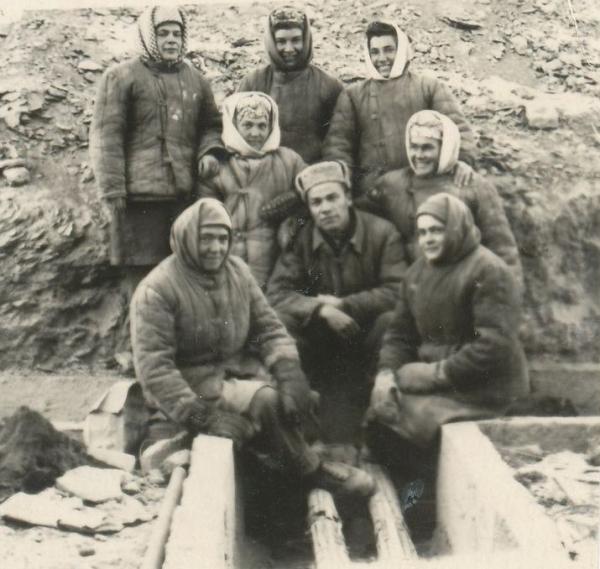
Political prisoners of various nationalities at a hard-labor camp in Kengir in the Kazakh Soviet Socialist Republic. A revolt at Kengir is recounted in The Gulag Archipelago by Aleksandr Solzhenitsyn. Creative Commons License. Photo from the Kaunas 9th Fort Museum.
Ongoing repression and Russification followed Stalin’s death. Russian immigration was encouraged as part of an effort to build huge industrial centers around coal and steel production as a way of creating a "working class" in the agriculture-dominated region. One such city, Karaganda, is one of the most polluted and environmentally dangerous cities in the world.
Between 1948 and 1989, the Soviet Union used the Kazakh SSR for most of its nuclear testing. In the Semipalatinsk region, a total of 752 nuclear tests, 152 aboveground, were carried out, creating another environmental catastrophe. A massive space and nuclear missile launching site was established at Baikonur, located in south-central Kazakhstan. It was the site of the Sputnik launch and still launches Russian and international spaceships.
Independence Without Freedom
In the mid-to-late 1980s, when Mikhail Gorbachev adopted perestroika and glasnost reforms, political movements arose in many Soviet republics in the form of Popular Fronts to press for faster change and to demand independence for union republics. In Kazakhstan, the Popular Front movement was sparked in part by student demonstrations in Alma Ata (later renamed Almaty) protesting the appointment of an ethnic Russian to replace an ethnic Kazakh Communist Party First Secretary. But the pro-democracy movement in Kazakhstan was not as strong as in the Baltic States or some other nations (see Estonia and Azerbaijan Country Studies. In the Kazakhstan Supreme Soviet elections held in March 1990, 342 of 360 seats still went to members of the Communist Party.
President Nazarbayev, systematically consolidated control over the state’s security services (the old KGB), the military, the economy and political structures.
Public protests and events in the rest of the Soviet Union led the Supreme Soviet to declare Kazakhstan’s sovereignty in October 1990. It then selected the First Secretary of the Communist Party, Nursultan Nazarbayev, as the republic’s president. After a coup in Moscow in August 1991 by hardline Soviet leaders failed, the process accelerated. Nazarbayev held an uncontested election for president of Kazakhstan on December 1, 1991. The Kazakhstan Supreme Soviet issued a declaration of independence on December 16. Nine days later, the Soviet Union formally dissolved.
Initially, there was greater freedom. New political parties, trade unions and media independent of communist structures arose. But President Nazarbayev, systematically consolidated control over the state’s security services (the old KGB), the military, the economy (especially newly discovered oil and gas fields) and political structures. To do so, he used authority granted in temporary constitutional laws. Nazarbayev governed as an autocrat for twenty-eight years before resigning in 2019 (see also Current Issues).
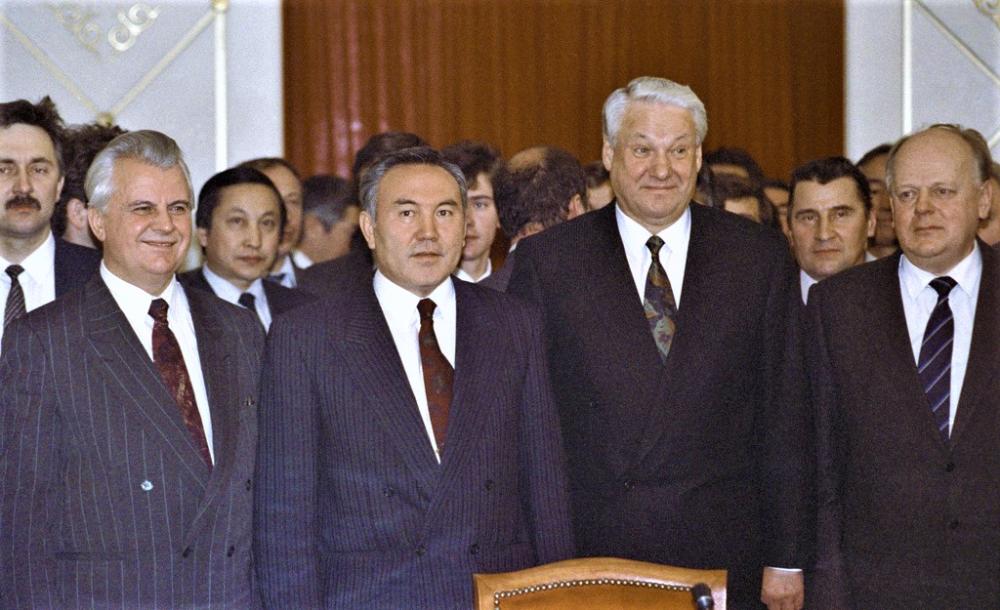
President Nursultan Nazarbayev (second from left), now president of independent Kazakhstan, joins 11 other former Soviet republics in creating the Commonwealth of Independent States. December 21, 1991. Creative Commons License. Photo by RIA Novosti archive (image #41059)/Dmitryi Donskoy.
Kazakhstan was an original member of the Commonwealth of Independent States formed in late December 1991 by eleven former Soviet republics. From that time, Kazakhstan hewed closely to the Russian Federation in its foreign policies. In December 1994, Nazarbayev signed the Budapest Memorandum by which Belarus, Kazakhstan and Ukraine agreed to removal of all nuclear weapons and weapons material on their territory in exchange for guarantees of territorial integrity. In 2014, Kazakhstan was one of three countries still to join the Russian Federation’s Eurasian Union. More recently, however, it has withheld full support for Russia’s invasion against Ukraine.
Below is a fuller description of Kazakhstan’s period of independence since 1991 and its lack of adherence to the essential principle of accountability and transparency.
Accountability and Transparency
Independent civic, trade union and human rights organizations and media outlets exist but on a limited basis, operating in conditions of repression and intimidation. Accountability and transparency are lacking at all levels.
The people and territory of Kazakhstan have been under foreign domination for much of its history, including forcible incorporation into the Soviet Union. Only with the collapse of the Soviet Union in December 1991 did Kazakhstan have an independent state. For nearly 30 years, it was governed by President Nursultan Nazarbayev, a former first secretary of the republic’s Communist Party. Nazarbayev systematically replaced the old Soviet dictatorship with an autocracy in which his absolute power went unchallenged. Upon resignation in 2019, Nazarbayev handed the presidency to Qasym-Jomart Toqaev. While Toqaev promised reforms, in January 2022 he violently suppressed demonstrations against price increases that grew into violent clashes. Since then, Toqaev has used the events to consolidate further his own power.
Independent civic, trade union and human rights organizations and media outlets exist but on a limited basis, operating in conditions of repression and intimidation. Accountability and transparency are lacking at all levels. In contrast to the other Country Studies in this section (Botswana and even the Philippines), Kazakhstan has no institutional safeguards against corruption or abuse of power.
A Controlled Election and a New Constitution
Kazakhstan's first parliamentary elections as an independent republic were held in March 1994 under a temporary constitution that already granted the president dominance over the government, the judiciary and the Central Election Commission.
In a controlled process, the Party of People’s Unity of Kazakhstan, formed by Nursultan Nazarbayev, claimed a plurality of seats. Allied parties and “independent” candidates ensured the president's continued dominance over the unicameral parliament, called the Majilis. Pro-democratic parties had emerged during the periods of perestroika and early independence, but they boycotted the elections due to blatantly unfair conditions.
A new constitution was approved in a staged referendum in August 1995. It established an absolute presidency without checks or balances on power. The president had the power to appoint and dismiss all members of the government and judiciary without parliament’s consent and he could dismiss the parliament at will. To fully cement control, the president’s approval is required for any amendments to the constitution. (One amendment was approved: to formally designate Nazarbayev as “father of the nation.”) The president appoints all members of the Central Electoral Commission, thus ensuring control over the electoral process.
The position of human rights ombudsman was created in September 2002, but the office is not authorized to investigate complaints regarding the president, parliament, Central Electoral Commission or the courts.
Soviet-Style Elections
President Nazarbayev continued to head the governing party, which was named Nur Otan (“Radiant Fatherland”) when it merged with other pro-presidential parties. The 2004 parliamentary elections brought complete control over the Majilis (one of the 107 seats went to a non-presidential party). In elections in 2007, called ahead of schedule, Nur Otan claimed all Majilis seats with a reported 88 percent of the vote. In 2012 elections, the Communist Party and the Aq Jol (“Bright Path”) Democratic Party were allowed to surpass the 7 percent threshold to gain 15 seats. Both parties form part of a “controlled opposition” and collaborate openly with Nur Otan.
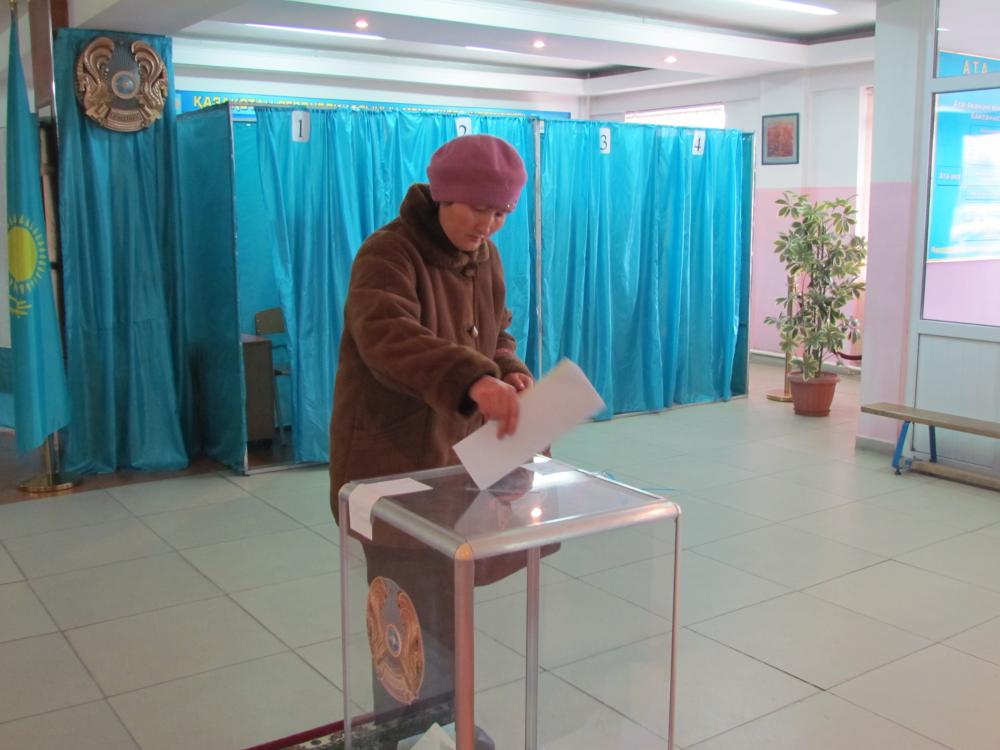
Elections since independence have not been free nor fair, with little doubt as to the outcome. In 2011 and 2015, Nursultan Nazarbayev received a Soviet-style 95.55 and 97.75 percent of the vote.
Nazarbayev claimed overwhelming victory in every presidential election since 1991 having only allowed token opposition to compete. Any genuine opposition candidates had their campaigns restricted or repressed.
Nazarbayev claimed overwhelming victory in every presidential election since 1991 having only allowed token opposition to compete. Any genuine opposition candidates had their campaigns restricted or repressed. Nazarbayev declined the parliament’s offer to be named “president-for-life” in 2009, but accepted parliament’s elimination of the two-term limit in the constitution. Elections in 2011 and 2015 had Soviet-like votes of 95.55 and 97.75 percent in his favor.
An example of how power is wielded was Nazarbayev’s decision to move the capital in 1994 from its largest city, Almaty, to a new, remote one named Astana (the Kazakh word for “capital” or “governing city”). The Majilis approved the president’s request without debate. The costly move created vast opportunities for corruption through construction projects necessary to establish a new capital city.
Civil Society Under Control
There are few independent non-governmental organizations (NGOs) willing to criticize the regime. Most civic or social organizations are generally known as GONGOs or Government Organized Non-Government Organizations.
Among the independent NGOs are Transparency International-Kazakhstan and the Kazakhstan International Bureau for Human Rights and Rule of Law (KIBHR), which report on corruption and human rights abuses (see Resources for web site links). Both organizations are under constant threat of deregistration and their members face repression.
The government also established strict controls on the registration of religious organizations following several 2011 bomb blasts that the government blamed on religious extremists. “Non-traditional” (meaning non-Sunni Muslim) religious groups are not allowed to practice freely.
Trade Unions and the Zhanaozen Protests
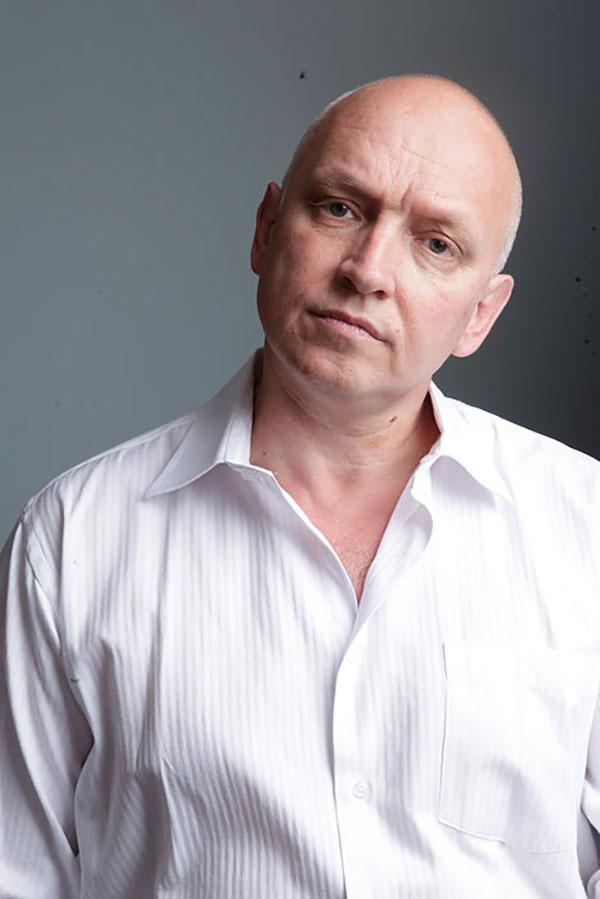
Vladimir Kozlov, an opposition leader, was sentenced to 7½ years’ imprisonment for investigating the 2011 Zhanaozen massacre and presenting findings to the European Parliament. Creative Commons License. Photo by Getimpact.
Freedom of association for workers is guaranteed by law but not in practice. The main trade union federation is the successor to the old communist structure and acts as a loyal adjunct of the government. Independent unions that arose in the early 1990s lacked resources and were weakened by repression. An example was in the western city of Zhanaozen.
In May 2011, thousands of oil workers went on strike to protest low wages and poor working conditions. Protests took place through December, when internal security forces violently attacked workers. At least 15 persons were killed and dozens of leaders and supporters of the strike were imprisoned. When a leader of an opposition political party, Vladimir Kozlov, reported findings of gross human rights violations to the European Parliament, he was arrested on his return, tried and sentenced to seven and one-half years imprisonment. The government then introduced a new labor code in March 2014 that restricted independent union registration. The International Labour Organization has repeatedly cited Kazakhstan for restrictions on freedom of association and other worker rights violations (see Human Rights Watch article on Zhanaozen’s legacy in Resources).
Transparency Is Nonexistent
The constitution provides for freedoms of speech and the press, but in practice major media are controlled by the government. Independent media did develop in the late 1980s and early 1990s under the Soviet policy of glasnost (“openness”). By the mid-90s, however, television and radio frequencies were limited in favor of private companies allied to the government. The largest media outlets were bought and taken over. A holding company controlled by Nazarbayev’s family ended up owning together the largest newspaper, television station and radio station. State-controlled or state-influenced media avoided criticism of the ruling party or the president (see Resources for the article by Sergei Duvanov, “What Happened to the Dream of Independent Media”).
The country's remaining independent and opposition media outlets, usually based online, faced harassment while journalists faced fines or imprisonment. Freedom House and Human Rights Watch reported cases of independent journalists facing physical attack, arrest and libel suits for bringing to light issues of corruption and abuses of power or reporting on such events as the Zhanaozen worker protests (see above).
Corruption, Rights Abuses, International Legitimacy
In general, the economy, largely dependent on oil and gas production, has been controlled by a network of clans tied to President Nazarbayev. He built a vast financial empire of money-making enterprises around family members. Nazarbayev regularly purged members of the economic elite who attempted to use their wealth to maneuver for power, including a son-in-law. Any agreements involving the government, including in energy, required bribes.
In general, the economy, largely dependent on oil and gas production, has been controlled by a network of clans tied to President Nazarbayev. He built a vast financial empire of money-making enterprises around family members.
The government’s practices were revealed early by Akejan Kajegeldin, a former prime minister who resigned in 1997 and later went into exile. He alleged that direct payments were received by Nazarbayev and other officials from Western energy companies and that Nazarbayev and other top officials maintain secret Swiss bank accounts to siphon money from the government.
Nazarbayev effectively deflected the international ramifications from the case, dubbed “Khazakgate,” and thwarted any domestic investigation. Independent journalist Sergei Duvanov, who exposed details of the corruption, was arrested in 2002 on trumped-up charges and sentenced to a three-and-a-half-year prison term. Nazarbayev pushed through a constitutional amendment in 2010 granting the president and his family immunity for any wrongdoing and protecting their property and assets.
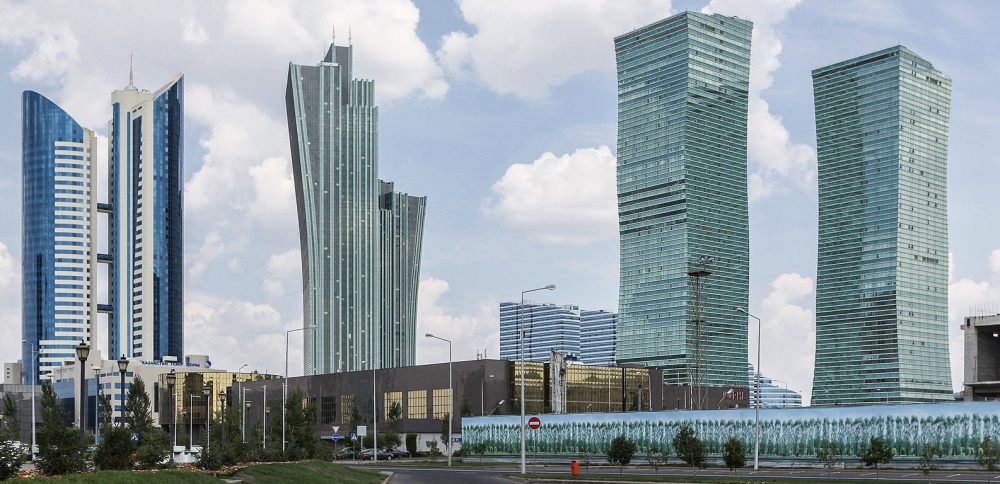
President Nazarbayev had parliament move the capital from Almaty to Akmola and rename it Astana (“governing city”) in 1998. Creative Commons License. Photo by Ninaras.
During his reign, Nazarbayev generally escaped international scrutiny or actions regarding corruption or his government’s human rights record. In the fall of 2006, he was granted a state visit to the United States by President George W. Bush. Kazakhstan was even awarded the rotating chairmanship of the Organization for Security and Cooperation in Europe (OSCE) in 2010.
Current Issues
After nearly thirty years in power, Nursultan Nazarbayev, at 79 years old, resigned as president in March 2019. The chairman of the Senate, 68-year-old Qasym-Jomart Toqaev, was appointed acting president pending a special election. In June, with only token opposition, Toqaev won a full term with a reported 71 percent of the vote as the candidate of the Nur Otan party. International observers deemed it a controlled and unfair process that denied genuine opposition parties to be on the ballot.
[T]here was “an absence of meaningful improvements in [Kazakhstan’s] rights record. Authorities cracked down on government critics . . . restricted the right to peaceful protest, suppressed free speech, and failed to address impunity for domestic violence and torture.”
The new president promised reforms, but changed little. As Human Rights Watch noted, there was “an absence of meaningful improvements in [Kazakhstan’s] rights record. Authorities cracked down on government critics, . . . restricted the right to peaceful protest, suppressed free speech, and failed to address impunity for domestic violence and torture.”
Toqaev remained overshadowed by the previous leader. Nazarbayev continued as head of the ruling Nur Otan party (renamed in his honor) and still served as “chairman for life” of the Security Council, a body with substantial powers over security and foreign affairs.
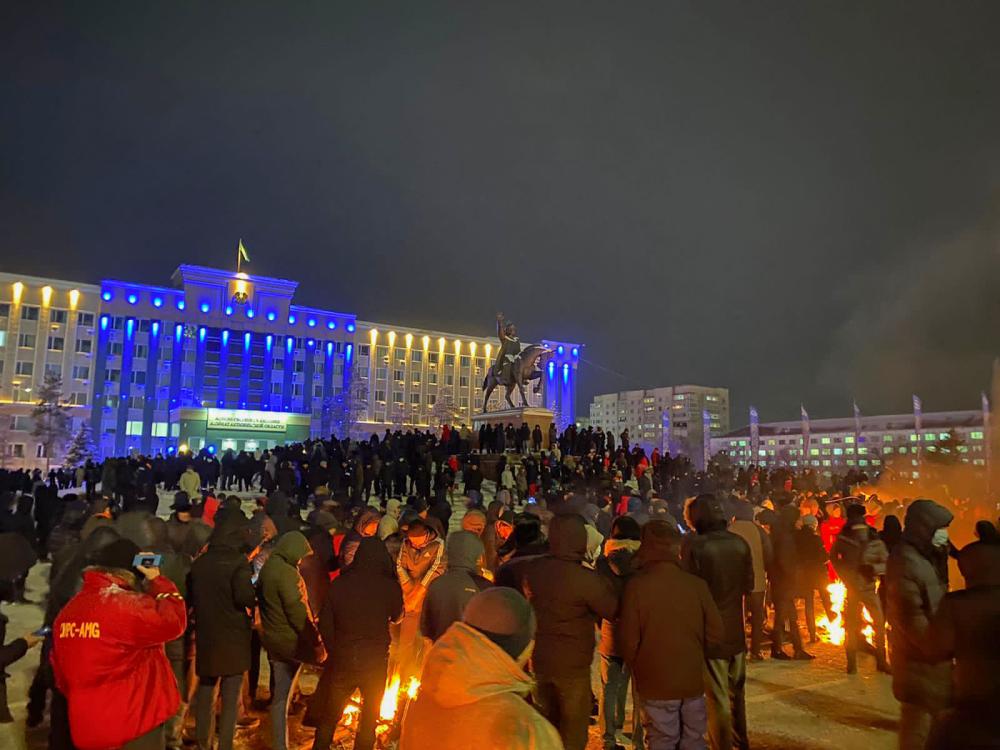
A demonstration in Aqtobe, a city in Western Kazakhstan near Zhanaozen, in January 2022 over price rises. President Qasym-Jomart Toqaev used violence against the protests as a means to consolidate power. Creative Commons License. Photo by Esetok.
This changed in early January 2022 when the country was racked by massive protests. They began peacefully in Zhanaozen, a city in western Kazakhstan that saw a government crackdown in 2011 (see above). On January 2, ten thousand workers marched to protest Toqaev’s main economic “reform,” which was lifting subsidies on liquefied natural gas that most Kazakhstanis use to power their cars. Its price had skyrocketed. The protests spread to other cities, including Aktau, where 16,000 workers protested, and then Kazakhstan’s largest and most populous city, Almaty, the former capital in eastern Kazakhstan.
In Almaty, the protests turned violent as genuine protesters found themselves in a clash between forces loyal to President Toqaev and those loyal to Nazarbayev’s security chief, Karim Masimov. The president declared a state of emergency, shut down the internet and dismissed the government, including top security officials. Toqaev also assumed control over the Security Council and secured support from the Russian Federation, which sent in several thousand troops to help Kazakh security forces. A “shoot to kill” order was issued to suppress the protests.
Toqaev ordered a policy of retribution, which was carried out by new security officials appointed by him. A reported 238 protesters were killed and six thousand detained. Nazarbayev loyalists were purged. Masimov and his deputy were arrested and formally charged with treason. (He was sentenced to 18 years’ imprisonment in 2023.) Seeing that his power had been eclipsed, Nazarbayev expressed support for Toqaev, announced his withdrawal from the Security Council and quickly receded from public view. His economic assets remained intact.
Toqaev assumed chairmanship of the Nur Otan party and rebranded it with the name Amanat (meaning “legacy”). Similarly, he had the Majilis return the capital’s name to Astana. (Like the name of the party, the capital had been renamed Nur-Sultan in honor of Nursultan Nazarbayev).
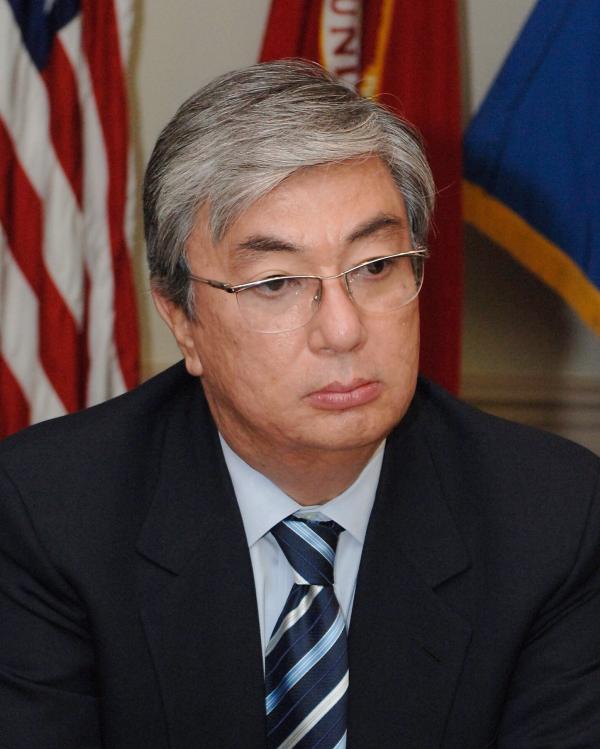
After nearly 30 years as president, Nursultan Nazarbayev resigned in March 2019 in favor of his long-time prime minister Qasym-Jomart Toqaev (shown here in 2005), but still retained substantial power.
Toqaev again promised reforms, but refused to allow any independent investigation of what became known as “Bloody January.” He did hold a referendum in June 2022 on 33 changes to the constitution. These supposedly carried out his promise to transfer powers to the Majilis but appeared designed instead to solidify Toqaev’s hold and remove residual powers given Nazarbayev after formally leaving as president. Toqaev retained full powers to appoint the prime minister, security ministers, other government officers and local governors without parliament’s approval.
Some changes appeared to allow a more open vote in parliamentary elections. They required Toqaev to resign from Amanat, made 29 seats open to direct constituency voting and allowed independent candidacies. But elections held on March 19, 2023 returned much the same result. The re-branded Amanat party received a lower percentage of the vote, 54 percent, but that still gave it supermajority control of the Majilis. Another establishment party (Auyl) came in second, at 11 percent. No genuine opposition party was allowed to register, while all individual opposition candidates for district seats lost in balloting that was widely reported as fraudulent (see Radio Free Europe article in Resources). While the government claimed a 54 percent turnout, election observers witnessed mostly empty polling stations.
• • •
Kazakhstan remains an autocracy. Newly adopted constitutional reforms provide no real checks on power. There also remains no accountability regarding the events of January 2022, much less the previous 30 years of dictatorship, government corruption and malfeasance. Media remains mostly under government control with independent outlets able to exist only online. Kazakhstan’s shutdown of the internet during protests mirrored other dictatorships facing public protest in their power to limit even such media.
The content on this page was last updated on .
